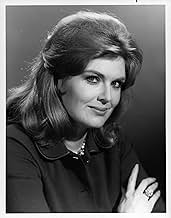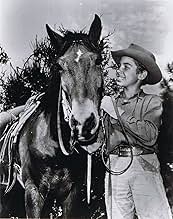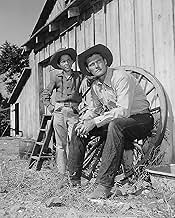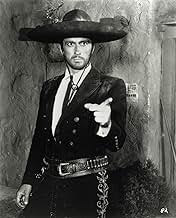The adventures of a Wild West rancher, wielding a customized rapid-fire Winchester rifle, and his son.The adventures of a Wild West rancher, wielding a customized rapid-fire Winchester rifle, and his son.The adventures of a Wild West rancher, wielding a customized rapid-fire Winchester rifle, and his son.
- Nominated for 2 Primetime Emmys
- 3 nominations total
Browse episodes
Storyline
Did you know
- TriviaIn the pilot, originally written for Gunsmoke (1955), Chuck Connors' character was named John McCain, he had no children and he was a dead shot with a pistol. Arnold Laven decided to make McCain a widower with a son whose weapon of choice was a customized Winchester rifle.
- GoofsLucas McCain's rifle is a modified 1892 .44-40 Winchester, even though the series clearly establishes itself in the 1880s.
- Quotes
[repeated line]
Mark McCain: Pa!
- ConnectionsFeatured in Saturday Night Live: Rick Moranis and Dave Thomas/The Bus Boys (1983)
Featured review
I don't know why they used a colorized photo to represent The Rifleman show on the video cover. If the video is colorized, that would be a good reason to not buy it. And I'm not particularly against colorized reprints. It's just that this show truly shined in its B&W mode.
As was demonstrated by Frankenheimer's The Train, a few cinematographers and directors reached a peak of artistic visual clarity during the late 50s-early 60s. This TV show was a good example of that artisanship. Such quality continues to be rare in TV production. You could say it's because TV production has always been a low-funded affair, but such fine art doesn't cost any more than the expensive stuff. What it takes is a highly talented cinematographer and director. That's the rarity, in both films and TV.
Viewers were certainly not jaded back then, nonetheless when a show aired on TV that was clearly well produced, in terms of b&w visual clarity, you can bet we uneducated viewers noticed it, if we weren't yet aware of why we were noticing it. The Rifleman was that kind of show. The screen of our old Zenith b&w console, not a high tech unit by any means, really lit up when this show came on. Like a musician who can take a shabby instrument and make it sing, this quality of production could somehow make our crummy old TV look better than it was worth. A real value, for free and on the air.
The opening sequence to every episode was exciting enough to suck any of us into the TV screen, with the camera dollying backwards in sinc with Connors moving forward repeatedly shooting/cocking his modified, cut-down rifle. No music yet. Nothing but bam, bam, bam, bam, bam, bam, bam, bam `The Rifleman' the seriously over-concerned voice-over would announce. We were hooked, and the western styled orchestral music would begin to play.
What is most striking as I vividly remember this shot now almost 40 years later, is the utter smoothness of Connor's walk and steady gaze as he moved forward step by slow step. I realize it is the exact same style of strong, silent type walk which Clint Eastwood was making a trademark. Funny to think that Connors, not a highly respected actor in circles, was doing this bit just as well as Eastwood did so many times later. Hey, if it works, work it. They had similar body types, and their plain, button-down western shirts fit in the same way. These were not the heavily muscled heroes today's boys are led to appreciate. They were tall, sinewy men, and it leant their characters a certain degree of intelligence along with the brawn.
Westerns were such a solid part of Hollywood movie studios' profit revenue, that's why artistic license was allowed the directors of these independently produced film/TV productions. Leave It to Beaver, believe it or not, was another great example of intelligent writing allowed into a stagnant arena of suburban styled family serials. Just check out the difference between Beaver and Dobie Gillis, as compared to Ozzie and Harriet and Gilligan's Island. The latter were undeniably stupid, one dimensional shows, while the former brought intelligent satire into play.
As I look back, a fatherless child at the time, Connors' brave good guy/bad guy characters really worked on me. This was where I managed to develop a diverse sense of humanity, because the directors and writers were allowed to make these characters and their stories somewhat multi-dimensional. The 60s was a great time, in terms of expanding a very innocent TV audience's view of the world outside our sheltered lives (there was never anything closely resembling CNN or Howard Stern, of course).
Two years after The Rifleman finished running there started a new Chuck Connors cowboy series called Branded. Where The Rifleman was certainly the most violently provocative show on TV, Branded was even more sadistic. As kids we ate it all up. In what is now understood to be a sort of Peckinpah tradition of graphic violence, these shows were the directors' training grounds for such sadistic style. They were really pushing the envelope of censorship. My mom used to get upset when we watched these shows.
As was demonstrated by Frankenheimer's The Train, a few cinematographers and directors reached a peak of artistic visual clarity during the late 50s-early 60s. This TV show was a good example of that artisanship. Such quality continues to be rare in TV production. You could say it's because TV production has always been a low-funded affair, but such fine art doesn't cost any more than the expensive stuff. What it takes is a highly talented cinematographer and director. That's the rarity, in both films and TV.
Viewers were certainly not jaded back then, nonetheless when a show aired on TV that was clearly well produced, in terms of b&w visual clarity, you can bet we uneducated viewers noticed it, if we weren't yet aware of why we were noticing it. The Rifleman was that kind of show. The screen of our old Zenith b&w console, not a high tech unit by any means, really lit up when this show came on. Like a musician who can take a shabby instrument and make it sing, this quality of production could somehow make our crummy old TV look better than it was worth. A real value, for free and on the air.
The opening sequence to every episode was exciting enough to suck any of us into the TV screen, with the camera dollying backwards in sinc with Connors moving forward repeatedly shooting/cocking his modified, cut-down rifle. No music yet. Nothing but bam, bam, bam, bam, bam, bam, bam, bam `The Rifleman' the seriously over-concerned voice-over would announce. We were hooked, and the western styled orchestral music would begin to play.
What is most striking as I vividly remember this shot now almost 40 years later, is the utter smoothness of Connor's walk and steady gaze as he moved forward step by slow step. I realize it is the exact same style of strong, silent type walk which Clint Eastwood was making a trademark. Funny to think that Connors, not a highly respected actor in circles, was doing this bit just as well as Eastwood did so many times later. Hey, if it works, work it. They had similar body types, and their plain, button-down western shirts fit in the same way. These were not the heavily muscled heroes today's boys are led to appreciate. They were tall, sinewy men, and it leant their characters a certain degree of intelligence along with the brawn.
Westerns were such a solid part of Hollywood movie studios' profit revenue, that's why artistic license was allowed the directors of these independently produced film/TV productions. Leave It to Beaver, believe it or not, was another great example of intelligent writing allowed into a stagnant arena of suburban styled family serials. Just check out the difference between Beaver and Dobie Gillis, as compared to Ozzie and Harriet and Gilligan's Island. The latter were undeniably stupid, one dimensional shows, while the former brought intelligent satire into play.
As I look back, a fatherless child at the time, Connors' brave good guy/bad guy characters really worked on me. This was where I managed to develop a diverse sense of humanity, because the directors and writers were allowed to make these characters and their stories somewhat multi-dimensional. The 60s was a great time, in terms of expanding a very innocent TV audience's view of the world outside our sheltered lives (there was never anything closely resembling CNN or Howard Stern, of course).
Two years after The Rifleman finished running there started a new Chuck Connors cowboy series called Branded. Where The Rifleman was certainly the most violently provocative show on TV, Branded was even more sadistic. As kids we ate it all up. In what is now understood to be a sort of Peckinpah tradition of graphic violence, these shows were the directors' training grounds for such sadistic style. They were really pushing the envelope of censorship. My mom used to get upset when we watched these shows.
- petermaxie
- May 30, 2002
- Permalink
Details
- Release date
- Country of origin
- Official site
- Language
- Also known as
- Westlich von Santa Fe
- Filming locations
- Production companies
- See more company credits at IMDbPro
- Runtime30 minutes
- Color
- Aspect ratio
- 4:3
Contribute to this page
Suggest an edit or add missing content


























